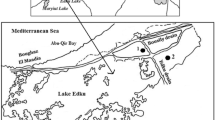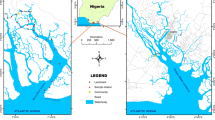Abstract
Polycyclic aromatic hydrocarbons (16 EPA list) were determined in oils, fish feed, and fillets from gilthead sea bream fed through a full production cycle (14 months) with feed containing different proportions of fish oil replaced by vegetable oils, followed by a finishing phase with fish oil. At the beginning of the study, fish presented 46.6 μg/kg fresh weight of the sum of PAHs in fillet and a benzo[a]pyrene equivalent value of 9.1 μg/kg fresh weight. These levels decreased after 330 days of rearing to values around 2 μg/kg. Although the concentration increased again during the finishing phase, they remained low. These low concentrations of PAHs could be the result of a dilution process associated with fish growth and with the detoxification pathways, both favored by the low levels of PAHs present in the feeds and the lack of any other potential source of contamination during the whole rearing period.


Similar content being viewed by others
References
Bell JG, McGhee F, Dick JR, Tocher DR (2005) Dioxin and dioxin-like polychlorinated biphenyls (PCBs) in Scottish farmed salmon (Salmo salar): effects of replacement of dietary marine fish oil with vegetable oils. Aquaculture 243:305–314
Benedito-Palos L, Navarro JC, Bermejo-Nogales A, Saera-Vila A, Kaushik S, Pérez-Sánchez J (2009) The time course of fish oil wash-out follows a simple dilution model in gilthead sea bream (Sparus aurata L.) fed graded levels of vegetable oils. Aquaculture 288:98–105
Berntssen MHG, Lundebye AK, Torstennsen BE (2005) Reducing the levels of dioxins and dioxin-like PCBs in farmed Atlantic salmon by substitution of fish oil with vegetable oil in the feed. Aquacult Nutr 11:219–231
Bethune C, Seierstad SL, Seljeflot I, Johansen O, Arnesen H, Meltzer HM, Rosenlund G, Froyland L, Lundebye AK (2006) Dietary intake of differentially fed salmon: a preliminary study on contaminants. Eur J Clin Invest 36:193–201
Bordajandi LR, Gómez G, Abad E, Rivera J, Del Mar Fernandez-Baston M, Blasco J, González MJ (2004) Survey of persistent organochlorine contaminants (PCBs, PCDD/Fs, and PAHs), heavy metals (Cu, Cd, Zn, Pb, and Hg), and arsenic in food samples from Huelva (Spain): levels and health implications. J Agric Food Chem 52:992–1001
Bordajandi LR, Martín I, Abad E, Rivera J, Gonzalez MJ (2006) Organochlorine compounds (PCBs, PCDDs and PCDFs) in sea fish and seafood from the Spanish Atlantic Southwest Coast. Chemosphere 64:1450–1457
Bories G (ed) (1988) Tossicologia e sicurezza degli alimenti. Tecniche Nuove, Milan, p 359
Commission Regulation (2006) Commission Regulation (EC) No 1881/2006 of 19 December 2006 setting maximum levels for certain contaminants in foodstuffs. Available from (eurlex.europa.eu/LexUriServ/site/en/oj/2006/l_364/l_36420061220en00050024.pdf)
Cortazar E, Bartolomé L, Arrasate S, Usobiaga A, Raposo JC, Zuloaga O, Etxebarria N (2008) Distribution and bioaccumulation of PAHs in the UNESCO protected natural reserve of Urdaibai, Bay of Biscay. Chemosphere 72:1467–1474
DouAbdul AAZ, Heba HMA, Farred KH (1997) Polynuclear aromatic hydrocarbons (PAHs) in fish from the Red Sea Coast of Yemen. Hydrobiologia 352:251–262
EPA (1987) Quality criteria for water. EPA 440/5–86-001. US Environmental Protection Agency, Washington DC
EPA (1993) Provisional guidance for quantitative risk assessment of polycyclic aromatic hydrocarbons. EPA 600/R-93/089. US Environmental Protection Agency, Washington DC
EPA (2000) Guidance for assessing chemical contaminant data for use in fish advisories. EPA. 823-B-00–008. US Environmental Protection Agency, Washington DC
Easton MDL, Luszniak D, Von der Geest E (2002) Preliminary examination of contaminant loadings in farmed salmon, wild salmon and commercial salmon feed. Chemosphere 46:1053–1074
Ferreira M, Moradas-Ferreira P, Reis-Henriques MA (2006) The effect of long-term depuration on phase I and phase II biotransformation in mullets (Mugil cephalus) chronically exposed to pollutants in River Douro Estuary, Portugal. Marine Environ Res 61:326–338
Fontcuberta M, Arqués JF, Martínez M, Suárez A, Villalbí JR, Centrich F, Serrahima E, Duran J, Casas C (2006) Polycyclic aromatic hydrocarbons in food samples collected in Barcelona, Spain. J Food Prot 69:2024–2028
Hellou J, Haya K, Steller S, Burridge L (2005) Presence and distribution of PAHs, PCBs and DDE in feed and sediments under salmon aquaculture cages in the Bay of Fundy, New Brunswick, Canada. Aquat Conserv 15:349–365
Hendricks JD, Meyeres TR, Shelton DW, Casteel JL, Bailey GS (1985) Hepatocarcinogenicity of benzo(a)pyrene to rainbow trout by dietary exposure and intraperitoneal injection. J Natl Cancer Inst 74:839–851
Hites RA, Foran JA, Carpenter DO, Hamilton MC, Knuth BA, Schwager SJ (2004) Assessment of organic contaminants in farmed salmon. Science 303:226–229
Jacobs MN, Santillo D, Johnston PA, Wyatt CL, French MC (1998) Organochlorine residues in fish oil dietary supplements: comparison with industrial grade oils. Chemosphere 37:1709–1721
Kennedy CJ, Higgs D, Tierney K (2004) influence of diet and ration level on benzo[a]pyrene metabolism and excretion in rainbow trout (Oncorhyncus mykiss). Arch Environ Contam Toxicol 47:379–386
Latimer JS, Zheng J (2003) Sources, transport and fate of PAHs in the marine environment. In: Douben PET (ed) PAH: an ecotoxicological perspective. Wiley, Chichester, UK, pp 9–33
Law RJ, Kelly C, Baker K, Jones J, McIntosh AD, Moffat CF (2002) Toxic equivalency factors for PAH and their applicability in shellfish pollution monitoring studies. J Environ Monit 4:383–388
Liang Y, Tse MF, Young L, Wong MH (2007) Distribution patterns of polycyclic aromatic hydrocarbons (PAHs) in the sediments and fish at Mai Po Marshes Nature Reserve, Hong Kong. Water Res 41:1303–1311
Llobet JM, Falcó G, Bocio A, Domingo JL (2006) Exposure to polycyclic aromatic hydrocarbons through consumption of edible marine species in Catalonia, Spain. J Food Prot 69:2493–2499
Loufty N, Fuerhacker M, Tundo P, Raccanelli S, Ahmed MT (2007) Monitoring of polychlorinated dibenzo-p-dioxins and dibenzofurans, dioxin-like PCBs and polycyclic aromatic hydrocarbons in food and feed samples from Ismailia city, Egypt. Chemosphere 66:1962–1970
Martí-Cid R, Bocio A, Llobet JM, Domingo JL (2007) Intake of chemical contaminants through fish and seafood consumption by children of Catalonia, Spain: health risks. Food Chem Toxicol 45:1968–1974
Martí-Cid R, Llobet JM, Castell V, Domingo JL (2008) Evolution of the dietary exposure to polycyclic aromatic hydrocarbons in Catalonia, Spain. Food Chem Toxicol 46:3163–3171
Martin-Skilton R, Saborido-Rey F, Porte C (2008) Endocrine alteration and other biochemical responses in juvenile trubot exposed to the Prestige fuel oil. Sci Total Environ 404:68–76
Maule AG, Gannam AL, Davis JW (2007) Chemical contaminants in fish feeds used in federal salmonid hatcheries in the USA. Chemosphere 67:1308–1315
Moret S, Conte LS (2000) Polycyclic aromatic hydrocarbons in edible fats and oils: occurrence and analytical methods. J Chromatogr A 882:245–253
Moret S, Dudine A, Conte LS (2000) Processing effects on the polyaromatic hydrocarbon content of grapeseed oil. J Am Oil Chem Soc 77:1289–1292
Nácher-Mestre J, Serrano R, Benedito-Palos L, Navarro JC, Lopez FJ, Pérez-Sanchez J (2009a) Effects of fish oil replacement and re-feeding on the bioaccumulation of organochlorine compounds in gilthead sea bream (Sparus aurata L.) of market size. Chemosphere 76:811–817
Nácher-Mestre J, Serrano R, Portolés T, Hernández F, Benedito-Palos L, Pérez-Sanchez J (2009b) A reliable analytical approach based on gas chromatography coupled to triple quadrupole and time of flight analyzers for the determination and confirmation of polycyclic aromatic hydrocarbons in complex matrices from aquaculture activities. Rapid Commun Mass Spectrom 23:2075–2086
Nisbet IC, LaGoy PK (1992) Toxic equivalency factors (TEFs) for polycyclic aromatic hydrocarbons (PAHs). Regul Toxicol Pharm 16:290–300
Oros DR, Ross JRM (2005) Polycyclic aromatic hydrocarbons in bivalves from the San Francisco estuary: spatial distributions, temporal trends, and sources (1993–2001). Marine Environ Res 60:466–488
Oterhals Å, Nygård E (2008) Reduction of persistent organic pollutants in fishmeal: a feasibility study. J Agric Food Chem 56:2012–2020
Oterhals Å, Solvang M, Nortvedt R, Berntssen MHG (2007) Optimization of activated carbon-based decontamination of fish oil by response surface methodology. Eur J Lipid Sci Technol 109:691–705
Perugini M, Visciano P, Giammarino A, Manera M, Di Nardo W, Amorena M (2007) Polycyclic aromatic hydrocarbons in marine organisms from the Adriatic Sea, Italy. Chemosphere 66:1904–1910
Pitarch E, Medina C, Portolés T, Lopéz FJ, Hernández F (2007) Determination of priority organic micro-pollutants in water by gas chromatography coupled to triple quadrupole mass spectrometry. Anal Chim Acta 583:246–258
Saeed T, Al-Yakoob S, Al-Hashash H, Al-Bahloul M (1995) Preliminary exposure assessment for Kuwaiti consumers to polycyclic aromatic hydrocarbons in seafood. Environ Int 21:255–263
Santerre CR, Ingram R, Lewis GW, Davis JT, Lane LG, Grodner RM, Wei CI, Bush PB, Xu DH, Shelton J, Alley EG, Hinshaw JM (2000) Organochlorines, organophosphates, and pyrethroids in channel catfish, rainbow trout, and red swamp crayfish from aquaculture facilities. J Food Sci 65:231–235
Schultz M, Schultz J (1982) Induction of hepatic tumors with 7, 12-dimethyl-benzantracene in two species of viviparous fishes (genus Poecillopsis). Environ Res 27:337–351
Serrano R, Barreda M, Blanes MA (2008a) Investigating the presence of organochlorine pesticides and polychlorinated biphenyls in wild and farmed gilthead sea bream (Sparus aurata) from the Western Mediterranean Sea. Marine Pollut Bull 56:963–972
Serrano R, Blanes MA, López FJ (2008b) Biomagnification of organochlorine pollutants in farmed and wild gilthead sea bream (Sparus aurata) and stable isotope characterization of the trophic chains. Sci Total Environ 389:340–349
Stegeman JJ, Lech JJ (1991) Cytochrome P-450 monooxygenase systems in aquatic species: carcinogen metabolism and biomarkers for carcinogen and pollutant exposure. Environ Health Perspect 90:101–109
Yunker MB, Macdonald RW, Vingarzan R, Mitchell RH, Goyette D, Sylvestre S (2002) PAHs in the Fraser river basin: a critical appraisal of PAH ratios as indicators of PAH source and composition. Org Geochem 33:489–515
Acknowledgment
This study was carried out with the financial support of the European Union Project: Sustainable Aquafeeds to Maximise the Health Benefits of Farmed Fish for Consumers (AQUAMAX), contract number 016249-2.
Author information
Authors and Affiliations
Corresponding author
Rights and permissions
About this article
Cite this article
Nácher-Mestre, J., Serrano, R., Benedito-Palos, L. et al. Bioaccumulation of Polycyclic Aromatic Hydrocarbons in Gilthead Sea Bream (Sparus aurata L.) Exposed to Long Term Feeding Trials with Different Experimental Diets. Arch Environ Contam Toxicol 59, 137–146 (2010). https://doi.org/10.1007/s00244-009-9445-1
Received:
Accepted:
Published:
Issue Date:
DOI: https://doi.org/10.1007/s00244-009-9445-1




